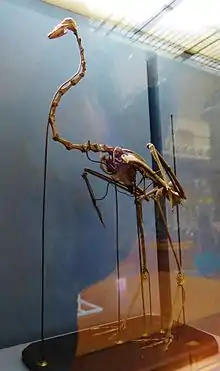Palaelodus
Palaelodus is an extinct genus of birds distantly related to flamingos. They were slender birds with long, thin legs and a long neck. Little is known about the shape of their skull or beak. Some paleontologists think Palaelodus was able to swim under water, chasing prey, but the morphology of their feet seems not very well adapted for diving. Rather, it is more likely that they were adapted to browsing for food while swimming or standing in shallow water.
| Palaelodus | |
|---|---|
 | |
| Palaelodus ambiguus skeleton, Muséum national d'histoire naturelle, Paris | |
| Scientific classification | |
| Kingdom: | Animalia |
| Phylum: | Chordata |
| Class: | Aves |
| Order: | Phoenicopteriformes |
| Family: | †Palaelodidae |
| Genus: | †Palaelodus Milne-Edwards, 1863 |
| Species | |
| |
| Synonyms | |
| |
The family, Palaelodidae, is the sister taxon of modern flamingos, and the order Phoenicopteriformes, to which both belong, probably evolved from a grebe-like ancestor. It is easy to see how a bird like Palaelodus represents an intermediate form between a diving, fish-eating grebe and a wading, invertebrate-filtering flamingo. This does not mean that the palaelodids are the ancestors of the flamingos. Rather, they were a sister group that remained in the ecological niche of their common ancestor.
Species

The number of species in the genus is disputed. The species P. ambiguus was found in Middle Oligocene to Middle Miocene (c. 29-12 mya) deposits of Western and Central Europe, being rare in Oligocene and much more common in Miocene strata;[1] there is also a probably record from the Oligocene/Miocene of Taubaté Basin in São Paulo, Brazil.[2] The Romanian fossil Grus miocaenicus is sometimes considered a synonym of this species. Other, somewhat doubtful species described from the Late Oligocene to Early Miocene (c. 28-23 mya) of French inland sites are P. gracilipes and P. crassipes which are most common in the Late Oligocene and later are replaced by P. ambiguus.[1]
From Late Oligocene to Middle Miocene (c. 28-12 mya) sites in Australia, two species, P. pledgei and P. wilsoni have been described.[3] The latter was also claimed from Middle Pleistocene deposits (roughly half a million years ago) in Australia; given the large temporal gap, it might not belong to the genus.
P. pledgei was described from fossil material (a proximal right tarsometatarsus and a distal right tibiotarsus) collected from Lake Palankarinna in the Lake Eyre Basin in north-eastern South Australia. P. wilsoni was described from several leg bones collected from Lake Palankarinna as well, and both were described in the same 1998 paper.[3]
P. aotearoa is from the Early Miocene of New Zealand. Two distal right tibiotarsi collected in 2008 and 2009 from the Saint Bathans Fauna of the Bannockburn Formation, Manuherikia River, in central Otago, South Island were described in 2010 as the type specimens of the species. The specific epithet is a Māori language name for New Zealand.[4]
On the other hand, the supposed crane Pliogrus germanicus is most likely a palaelodid. Sometimes Megapaloelodus goliath is included in Palaelodus.
References
- Hugueney, M.; Berthet, D; Bodergat, A.-M.; Escuillié, F; Mourer-Chauviré, C; Wattinne, A (2003). "La limite Oligocène-Miocène en Limagne-changements fauniques chez les mammifères, oiseaux et ostracodes des différents niveaux de Billy-Créchy (Allier, France)". Geobios (in French). 36: 719–731. doi:10.1016/j.geobios.2003.01.002.
- Alvarenga, H.M.F. (1990). "Flamingos Fósseis da Bacia de Taubaté, Estado de São Paulo, Brasil: Descrição de Nova Espécie". Anais da Academia Brasileira de Ciências. 62 (4): 335–345.
- Baird, RF; Vickers-Rich, P (1998). "Palaelodus (Aves: Palaelodidae) from the Middle to Late Cainozoic of Australia". Alcheringa. 22: 135–151. doi:10.1080/03115519808619196.
- Worthy, Trevor H.; Tennyson, Alan J.D.; Archer, Michael & Scofield, R. Paul (2010). "First record of Palaelodus (Aves: Phoenicopteriformes) from New Zealand". In W.E. Boles & T.H. Worthy. (eds.). Proceedings of the VII International Meeting of the Society of Avian Paleontology and Evolution (PDF). Records of the Australian Museum. 62. pp. 77–88. doi:10.3853/j.0067-1975.62.2010.1545.
- Milne-Edwards, Alphonse (1863). "Mémoire sur la distribution géologique des oiseaux fossiles et description de quelques espèces nouvelles". Annales des Sciences Naturelles (in French). 4 (20): 132–176.
- Mayr, Gerald (2006). "The contribution of fossils to the reconstruction of the higher-level phylogeny of birds" (PDF). Species, Phylogeny and Evolution. 1: 59–64. ISSN 1864-211X. Retrieved 12 August 2009.
- Mayr, Gerald (2004). "Morphological evidence for sister group relationship between flamingos (Aves: Phoenicopteridae) and grebes (Podicipedidae)" (PDF). Zoological Journal of the Linnean Society. 140 (2): 157–169. doi:10.1111/j.1096-3642.2003.00094.x. ISSN 0024-4082. Retrieved November 3, 2009.